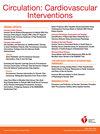Risk Burden of Cancer in Patients Treated With Abbreviated Dual Antiplatelet Therapy After PCI: Analysis of Multicenter Controlled High-Bleeding Risk Trials
IF 6.1
1区 医学
Q1 CARDIAC & CARDIOVASCULAR SYSTEMS
Circulation: Cardiovascular Interventions
Pub Date : 2024-04-16
DOI:10.1161/circinterventions.122.013000
引用次数: 0
Abstract
BACKGROUND:Oncological patients with coronary artery disease face an elevated risk of hemorrhagic and ischemic events following percutaneous coronary intervention. Despite medical guidelines recommending minimal dual antiplatelet therapy (DAPT) duration for patients with cancer, dedicated data on abbreviated DAPT in this population is lacking. This study aims to evaluate the occurrence of ischemic and hemorrhagic events in patients with cancer compared with other high-bleeding risk individuals.METHODS:Patient-level data from 4 high-bleeding risk coronary drug-eluting stent studies (ONYX One, LEADERS FREE, LEADERS FREE II, and SENIOR trials) treated with short DAPT were analyzed. The comparison focused on patients with high-bleeding risk with and without cancer, assessing 1-year rates of net adverse clinical events (all-cause death, myocardial infarction, stroke, revascularization, and Bleeding Academic Research Consortium [BARC] types 3 to 5 bleeding) and major adverse clinical events (all-cause death, myocardial infarction, stroke).RESULTS:A total of 5232 patients were included, of whom 574 individuals had cancer, and 4658 were at high-bleeding risk without previous cancer. Despite being younger with fewer risk factors, patients with cancer had higher net adverse clinical event (HR, 1.25; P=0.01) and major adverse clinical event (HR, 1.26; P=0.02), primarily driven by all-cause mortality and major bleeding (BARC 3–5), but not myocardial infarction, stroke, stent thrombosis, or repeat revascularization. Cancer was an independent predictor of net adverse clinical event (P=0.005), major adverse clinical event (P=0.01), and major bleeding (P=0.03).CONCLUSIONS:The present work is the first report on abbreviated DAPT dedicated to patients with cancer. Cancer is a major marker of adverse outcomes and these events had high lethality. Despite short DAPT, patients with cancer experienced higher rates of major bleeding compared with patients without cancer with high-bleeding risk, which occurred mainly after DAPT discontinuation. These findings reinforce the need for a more detailed and individualized stratification of those patients.REGISTRATION:URL: https://www.clinicaltrials.gov; Unique identifiers: NCT03344653, NCT01623180, NCT02843633, NCT0284.PCI术后接受简短双联抗血小板疗法患者的癌症风险负担:多中心对照高出血风险试验分析
背景:患有冠状动脉疾病的肿瘤患者在经皮冠状动脉介入治疗后发生出血和缺血性事件的风险较高。尽管医疗指南建议癌症患者尽量缩短双联抗血小板疗法(DAPT)的疗程,但目前尚缺乏关于该人群缩短DAPT疗程的专门数据。本研究旨在评估癌症患者与其他高出血风险人群相比发生缺血性和出血性事件的情况。方法:分析了 4 项高出血风险冠状动脉药物洗脱支架研究(ONYX One、LEADERS FREE、LEADERS FREE II 和 SENIOR 试验)中采用短 DAPT 治疗的患者水平数据。结果:共纳入了 5232 例患者,其中 574 例患有癌症,4658 例为高出血风险且未患过癌症的患者。尽管癌症患者更年轻,风险因素更少,但他们的净不良临床事件(HR,1.25;P=0.01)和主要不良临床事件(HR,1.26;P=0.02)却更高,主要原因是全因死亡率和大出血(BARC 3-5),而不是心肌梗死、中风、支架血栓或重复血管再通。癌症是净不良临床事件(P=0.005)、主要不良临床事件(P=0.01)和大出血(P=0.03)的独立预测因素。癌症是不良后果的主要标志,这些事件的致死率很高。尽管DAPT时间较短,但与出血风险较高的非癌症患者相比,癌症患者的大出血率较高,且主要发生在DAPT停药后。这些发现加强了对这些患者进行更详细和个体化分层的必要性。注册:URL:https://www.clinicaltrials.gov;唯一标识符:NCT03344653、NCT01623180、NCT02843633、NCT0284。
本文章由计算机程序翻译,如有差异,请以英文原文为准。
求助全文
约1分钟内获得全文
求助全文
来源期刊

Circulation: Cardiovascular Interventions
CARDIAC & CARDIOVASCULAR SYSTEMS-
CiteScore
10.30
自引率
1.80%
发文量
221
审稿时长
6-12 weeks
期刊介绍:
Circulation: Cardiovascular Interventions, an American Heart Association journal, focuses on interventional techniques pertaining to coronary artery disease, structural heart disease, and vascular disease, with priority placed on original research and on randomized trials and large registry studies. In addition, pharmacological, diagnostic, and pathophysiological aspects of interventional cardiology are given special attention in this online-only journal.
文献相关原料
| 公司名称 | 产品信息 | 采购帮参考价格 |
|---|
 求助内容:
求助内容: 应助结果提醒方式:
应助结果提醒方式:


